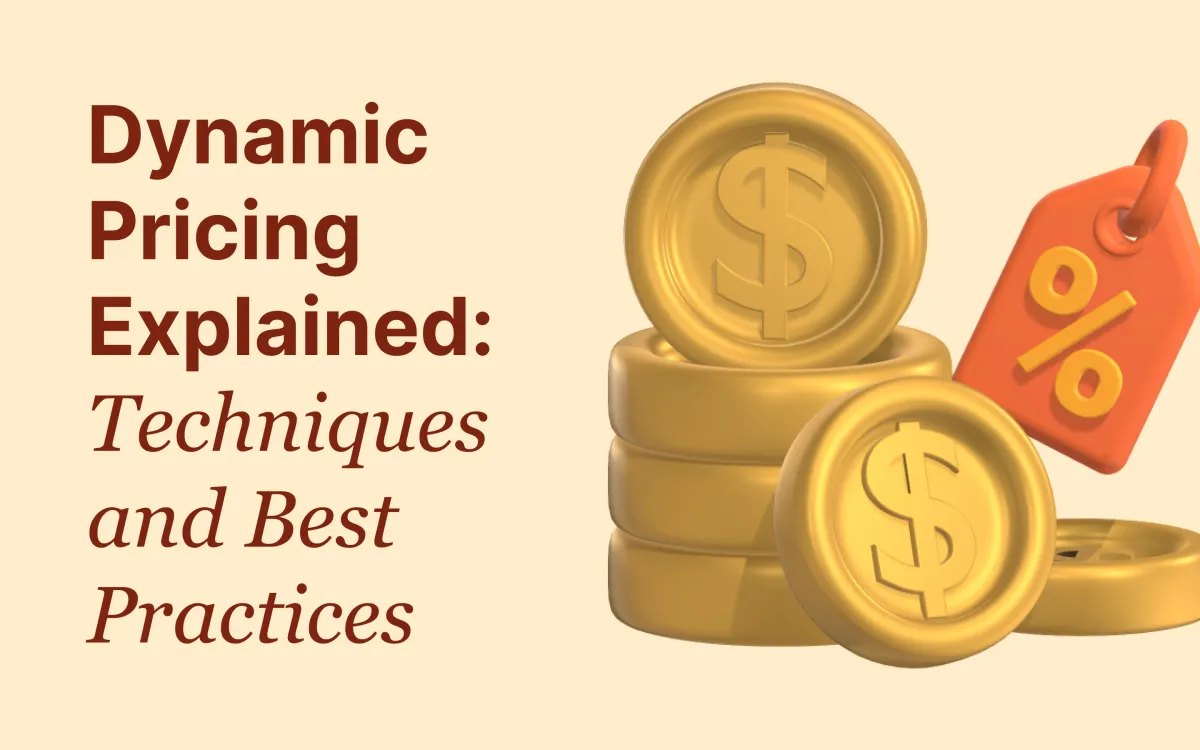Dynamic Pricing for Ecommerce Explained: Techniques and Best Practices
Dynamic Pricing for Ecommerce uses current market trends and what customers do to change prices as needed to boost profits and stay competitive.

Dynamic pricing can be challenging for business owners. You want to earn the best possible amount for your products or services without setting prices too high and losing potential customers.
Nowadays, businesses have access to a lot more information about current supply and demand, which helps them increase profits through a method known as dynamic pricing.
If you've ever tried to book an Uber during bad weather and noticed the prices skyrocketing, you've experienced dynamic pricing firsthand.
Although it's not a new strategy, travel and hospitality businesses have used it for a long time, it has become especially important in today's online shopping world.
Definition of Dynamic Pricing
Dynamic pricing is a pricing strategy where businesses set flexible prices for products or services based on current market demands, supply conditions, and other variables such as customer behavior or competitor prices.
Dynamic pricing optimization allows prices to fluctuate, often in real-time, to match the changing conditions of the marketplace, maximizing both sales volume and profits.
Dynamic pricing algorithm is widely used in industries like travel, hospitality, and e-commerce, where demand can change rapidly and pricing needs to adjust accordingly to remain competitive.
Core Concepts of Dynamic Pricing

Dynamic pricing can seem complex, but it essentially boils down to adjusting prices based on several key factors.
Here's a breakdown of some fundamental concepts that make up dynamic pricing machine learning:
1. Demand-based Pricing
Demand-based pricing is all about setting prices according to how much customers want a product or service at any given time. For instance, if there's a big concert in town and everyone is trying to book a ride there, prices for rides might go up.
Demand-based pricing method helps businesses capitalize on increased demand, ensuring they get the best possible price when their offerings are most wanted.
2. Time-based Pricing
Here, prices change depending on the time of day, week, or even season. Think about how hotels are more expensive during holidays or how some online services offer discounts during off-peak hours.
Time-based pricing strategy helps businesses manage demand across different times, encouraging customers to buy at times when demand is typically lower.
3. Segmented Pricing
Segmented pricing concept involves setting different prices for different groups of customers. It’s like how students or seniors might get discounts at movie theaters.
Businesses use this dynamic yield pricing strategy to reach broader markets by adjusting prices based on the specific characteristics and willingness to pay of different customer segments.
These pricing strategies help businesses stay flexible and responsive to market conditions, ensuring they can attract the right customers at the right time while maximizing their profits.
Implementation Strategies for Dynamic Pricing

Dynamic pricing system isn't just about knowing when to change prices, but also how to apply those changes strategically.
Here are some common dynamic pricing icon strategies businesses use:
1. Peak Pricing
Peak Pricing strategy involves raising prices when the demand for a product or service is at its highest.
For example, during a popular event in town, local hotels might increase their room rates because more people are looking for a place to stay. Peak Pricing strategy helps businesses capitalize on times when they're most likely to get higher sales at higher prices.
2. Penetration Pricing
When entering a new market or launching a new product, some businesses set their dynamic pricing revenue management very low initially.
This low pricing helps attract customers away from competitors and quickly gain a foothold in the market. Over time, as they build a customer base and establish their product, they might gradually increase prices.
3. Yield Management
Yield management is a sophisticated dynamic pricing business strategy used especially in industries like airlines and hotels, where it’s crucial to manage a fixed number of seats or rooms. Businesses forecast demand and adjust prices to maximize revenue.
For instance, an airline might lower prices early on to fill seats and then increase them as the flight date approaches and fewer seats are available. This ensures they make the most money possible from each flight.
Technological Aspects of Dynamic Pricing

Dynamic pricing heavily relies on technology to analyze market conditions and adjust prices accordingly.
Here’s a closer look at some of the key technological tools and methods involved:
1. Real-time Pricing
Real-time pricing method allows businesses to change dynamic pricing price discrimination instantly based on what’s happening in the market at any given moment.
For example, online retailers might increase the price of umbrellas as soon as it starts raining, knowing that more people will be looking to buy them. This immediate response to market changes helps businesses stay competitive and maximize profits by capitalizing on sudden shifts in demand.
2. Algorithmic Pricing
Algorithms are sets of rules or instructions programmed into computers to help make decisions. In the case of dynamic pricing, algorithmic pricing analyze data like customer behavior, competitor prices, and stock levels to automatically adjust prices without human intervention.
Algorithmic pricing makes the pricing process faster and can often predict the best pricing strategy more accurately than humans.
3. Machine Learning in Pricing
Machine learning is a type of artificial intelligence that improves automatically through learning from data.
In dynamic pricing, machine learning models can predict future market trends and customer demand by analyzing past sales data and market conditions. This predictive power allows businesses to adjust their pricing strategies proactively, often leading to better pricing accuracy and efficiency.
Ethical and Competitive Considerations in Dynamic Pricing

While dynamic pricing offers numerous advantages, it also brings up some ethical and competitive issues that businesses need to consider:
1. Price Discrimination
Price discrimination involves charging different prices to different customers for the same product or service. While it can be a useful strategy to maximize sales and reach diverse market segments, it also raises ethical concerns.
For instance, charging higher prices based solely on geographic location or purchase history might be seen as unfair or discriminatory. Businesses must navigate these practices carefully to maintain fairness and comply with legal standards that aim to prevent discriminatory pricing.
2. Competitive Pricing
Keeping an eye on what competitors are charging and adjusting prices in response is a common strategy in dynamic pricing. Competitive pricing approach helps businesses stay competitive in the market by not pricing themselves too high or too low compared to others.
However, a competitive pricing strategy must be used wisely to avoid price wars, which can lead to drastically lowered industry prices, hurting all players in the market over time.
5 Benefits of Dynamic Pricing Explained

Dynamic pricing is a strategy that adjusts prices based on real-time supply and demand.
Here are five straightforward benefits this approach offers to businesses:
1. Maximized Revenue
Dynamic pricing helps businesses make the most money possible, especially when the demand is high.
For example, during a holiday season when more people are shopping, stores might raise prices. This way, businesses earn more by selling products at higher prices when people are most eager to buy.
2. Enhanced Competitiveness
With dynamic pricing, businesses can quickly change their prices to match or beat competitors. This fast response to what others in the market are doing helps a business stay ahead, keeping it competitive and attractive to customers who are looking for the best deals.
3. Efficient Inventory Management
This pricing strategy helps companies manage their stock better. By lowering prices, businesses can clear out excess inventory that isn't selling. Conversely, they can raise prices to slow down sales and prevent running out of items too quickly. This balance helps avoid waste and ensures products are available when customers want them.
4. Customer Segmentation
Dynamic pricing allows businesses to offer different prices to different groups of people. For example, a business might charge lower prices to students or seniors. This price intelligence approach helps attract and retain a diverse customer base by appealing to various groups’ specific needs and budget constraints.
5 Challenges of Dynamic Pricing Explained

Dynamic pricing offers several benefits, but it also presents some challenges that businesses need to manage carefully.
Here are five significant challenges associated with dynamic pricing:
1. Customer Perception and Satisfaction
Dynamic pricing can lead to customer dissatisfaction if not managed transparently. Customers may feel unfairly treated if they discover that prices have increased sharply in a short period or if they pay more than others for the same product or service. This perception can harm a brand's reputation and customer loyalty.
2. Complexity in Pricing Strategy
Implementing dynamic pricing requires sophisticated systems and algorithms to analyze data and adjust prices in real-time. Developing and maintaining these systems can be complex and costly. Additionally, businesses need to ensure that their pricing strategies are aligned with overall business goals, which adds another layer of complexity.
3. Regulatory and Legal Risks
There are legal and regulatory considerations to keep in mind with dynamic pricing. Some regions have laws against discriminatory pricing practices, and businesses must ensure they comply with these regulations to avoid legal issues.
4. Market Volatility
Relying on dynamic pricing makes a business more sensitive to market fluctuations. Sudden changes in demand or supply can lead to rapid price changes that may not always be in the company's favor, potentially leading to revenue losses if not predicted correctly.
Future Trends in Dynamic Pricing
Looking ahead, dynamic pricing is likely to become even more sophisticated with advancements in technology. Artificial intelligence (AI) and price monitoring machine learning will play bigger roles, making price adjustments even more accurate and timely.
We might also see wider adoption across various industries beyond travel and retail, such as in utilities or healthcare, where pricing can be adjusted based on usage and demand in real-time.
Conclusion
Dynamic pricing is a flexible strategy that adjusts prices based on real-time demand and supply. It helps businesses maximize revenue, stay competitive, manage inventory efficiently, attract a broad customer base, and make informed decisions based on data.
For consumers, while it can mean price fluctuations, it also often leads to better deals and pricing fairness based on demand and availability.
Frequently Asked Questions
1. What is the meaning of dynamic price?
Dynamic pricing means changing the price of a product or service in real-time based on demand and supply. For example, if a lot of people want to buy something and there's not much of it left, the price might go up.
2. Why is dynamic pricing important?
Dynamic pricing is important because it helps businesses adjust their prices quickly to meet market conditions. This can help them sell more products, make more money, and stay competitive.
3. What are the pros and cons of dynamic pricing?
Pros of dynamic pricing: Helps maximize revenue by increasing prices when demand is high. Can attract more customers by lowering prices when demand is low. Allows businesses to respond quickly to market changes and competitor prices.
Cons: Customers might get upset if they see prices change frequently or feel they're paying more than others. It can be complex to implement and requires sophisticated technology. There's a risk of legal issues if not managed properly, especially around price discrimination.
4. What is dynamic pricing in business?
In business, dynamic pricing is a strategy where companies adjust their prices on the fly to match what customers are willing to pay at any given moment. It's used by many types of businesses, such as airlines, hotels, and online retailers, to ensure they are charging the right price at the right time to optimize sales and profits.
